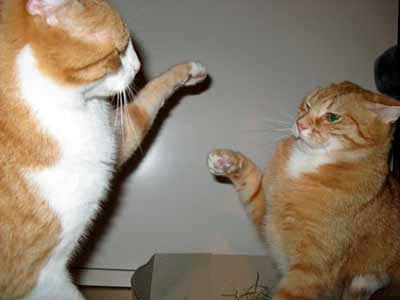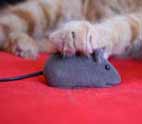Cat Aggression Truama
Cat aggression truama can sometimes be due to upset or fear and not real aggression at all.
Many owners have come to me asking why their loving cat has suddenly started to hiss and act aggressively towards them, or another family pet that they previously got on with just fine.
The answer is not always apparent at first, but in most cases it is due to some sort of upset which has made them feel afraid and the normal reaction to fear for a cat is to attack.
Quick guide to this page:
- Possible causes of sudden fear
- Cat Aggression Truama - What is it?
- Treating the symptoms of this sudden aggression
Causes of Sudden Fear
Cat aggression truama can be triggered by all sorts of things that may trigger a response of fear and sometimes our feline companions can become hyper-sensitive to all sorts of frights and surprises (occasionally it can help to use a mild calming medicine or herbal supplement such as Calm Care to help sooth our kitty down until they learn that there is nothing to be afraid of).
The trick is to find out what the cause of their fear could be and if possible to try and stop it from happening again. Or at the very least to be able to recognize the causes of your cat’s aggression next time.

Some possible causes are:
- A sudden loud bang or other noise
- Having their tail stepped on or pulled by a child
- New and strange smells in the home
- Changes in the home, e.g. furniture being moved or building work happening
- Changes in the smell or behaviour of other animals (e.g after a visit to the vet)
- New born babies and all the new smells, sounds and things coming into the home.
- Changes in the owners behaviour; e.g. due to illness, arguments, changing work patterns etc
- New pets moving into the area
This is just a short list of some of the possible causes of cat aggression truama but there could be many more which we may simply not notice.
Cat Aggression Truama
The thing about aggression truama is that it can trigger a very strange response from cats. For instance they may suddenly attack your other pet just because they have been frightened by a loud noise. The cause of the fear was not the other animal, but they seem to get blamed for it. This is a normal response and is one of the main reasons why owners become confused when this cat aggression occurs.
We notice this behaviour ourselves when our Byron is scared of something outside. Our other cat, poor Shelley, gets hissed and scratched at by Byron even though Shelley has done nothing wrong himself.
Cats don’t rationalise things in their minds, all they know is that they feel afraid and (often like some humans) will lash out at the nearest thing. Once this has happened, the association of fear and the object of attack are fixed and this aggressive cat behaviour can continue long after the initial fear has gone.
The risk is that it becomes an ingrained habit and an ongoing behaviour problem.
|
A natural product to:
|
Building Bridges To Recovery
So what can we do to help our cats get over their fear and to help them return to normal happy relationships with other pets and people? Discipline is not the answer, instead we need to help rebuild our cats confidence once again.
Over the years I have seen this cat aggression happen many times and in all cases the only thing which seems to work is a period of re-introduction with other animals in the home and bonding techniques with humans. This is not a quick fix and does take some time and effort, but in the long run it really is worth it for a happy home.
The re-introduction process is the same technique for introducing new pets to each other and should be carried out over a period of a week depending on your cat’s response.
You need to:
- Keep the cat which is behaving aggressively in a separate room by themselves for a day. This gives them time to relax and calm down without having to worry about other pets. This room should contain their toys, bed, litter tray and water. Visit them regularly for a little play and to feed them.
- Rub the non aggressive cats scent onto a fresh clean towel and then rub the towel around the confined pet’s room on day two. This will introduce the other animals scent again and help the aggressive cat to become used to this smell.
- On day three put your aggressive cat into a carrier and allow the other pet to come into the room for a few minutes. There may be some hissing but stay calm and quiet. Repeat this process until the hissing stops.
- This introduction process can be done several times a day and over as many days as needed for your pets to become used to each other again.
- When you feel that the cats are no longer reacting to each other in an aggressive way you can allow them to meet each other under your supervision without the pet carrier. Rub and stroke both of them and perhaps play a game with them or offer them treats to help distract them from any possible remaining fear they may have with each other.
This process may seem a little long, but when cat aggression truama caused by fear takes hold and if it is not dealt with correctly in this way, it can lead to having very unhappy cats which never fully relax with each other again.
Top of this Cat Aggression Page






